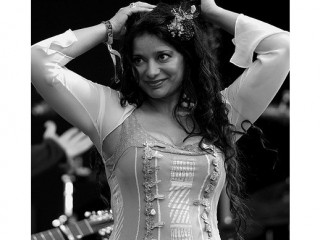
Sheila Chandra biography
Date of birth : 1965-04-14
Date of death : -
Birthplace : London,England
Nationality : English
Category : Arts and Entertainment
Last modified : 2011-11-02
Credited as : Singer, Monsoon, The Imagined Village
3 votes so far
Chandra's exposure to show business began early. For two years, beginning at age 13, she starred in a popular British Broadcasting Corporation TV series called "Grange Hill." Then, at age 16, she joined with Steve Coe and Martin Smith to form Monsoon, a band intent on making Asian pop fusion music with a largely acoustic sound. Monsoon's first single, "Ever So Lonely" broke into the British top ten and was followed quickly by another single, "Shakti (The Meaning of Within)" which also sold well. No doubt Chandra's strikingly exotic appearance added to public interest.
While Monsoon's label, Mercury/Phonogram, "felt that they [Monsoon] should continue to remake the hits they just made," as Joe Compton wrote in Dirty Linen magazine in 1993, the band wasn't interested. They were determined to explore and experiment with Indian sounds and so the label association ended. However, Coe, Martin and Chandra stuck together and would make five Sheila Chandra solo LPs. The albums appeared on Coe and Chandra's Indipop label, which had been formed for that purpose.
All this took place before Chandra turned 20. The first Indipop album was the aptly-titled Out On My Own in 1983, which reached the top 40 in Scandinavia. Thereafter came Quiet, followed by Nada Brahma and The Struggle in 1985. These albums featured the usual Western instruments, alongside traditional Indian instrumentation-- for example sitar, clay pot-shaped drums and the somewhat bongo-like drums called tablas. By the time of Quiet, all traces of Chandra's incarnation as Monsoon's vocalist had disappeared. This album featured little in the way of lyrics, consisting rather of bols music, a traditional South Indian form that consists of singing the rhythmical notes assigned to the tablas, which, in India, only the men perform.
The demanding pace of Chandra's early TV work, followed by her work with Monsoon and then a spate of the four solo albums led to a decision by Coe and Chandra, who married in 1985, to withdraw for a time. They moved to the famed and lovely Lake District of England. There, Chandra dedicated herself to some of the reflection and growth she had been singing about. When she emerged with Roots and Wings in 1989, the content reflected the listening Chandra had been doing to sources as varied as eastern European singing, southeast Asian song and, of course, classical Indian music--though she shunned Indian film or pop music.
Celtic music also now seemed an influence on Chandra as evidenced by her rendition of "Lament of McCrimmon" on Roots and Wings. This taste for folk music of the British Isles continued into her 1993 album Weaving My Ancestor's Voices, which included the song "Donalogue" and also the British folksong "Enchantment." Chandra found some lyrics in both these songs demeaning to women and did not hesitate to rewrite the words to fit her idea of a more proper vision. Folk music is a music that evolves to reflect the culture, Chandra reasoned, and this justified modernizing. Chandra not only found influence in the old songs of Britain but also in its current female bards, such as June Tabor, Maddy Prior and Sandy Denny.
Chandra's attention to more widespread cultural influences did not mean abandonment of her Indian bols singing, but she would now play with that tradition, improvising non-traditional patterns, for instance. In Zen Kiss, which appeared in 1994, her bols singing had evolved considerably. As Iris Brooks wrote in Rhythm Music Magazine in 1994, "the bols serve only as starting points, to which Chandra adds a multitude of other vocal sounds: bird songs, counting in Hindi and Finnish, parodies of commercial advertisements and elocution exercises and snippets of nonsense syllables." Yet, Brooks concluded, these pieces were not simply "world scat improvisations," but sounded like carefully assembled sampling work. However, Chandra did not use studio-sampling techniques. On this point, Brooks notes, Sheila Chandra calls these works "post-sampling compositions" and explained that "I wouldn't have written them if I hadn't heard what people are doing with samplers."
In 1992 Chandra joined that year's WOMAD tour, her first real work as a stage performer, and drew the attention of Peter Gabriel's label, Real World. Garbed in traditional dress and wearing the bindi, a dot of color on the forehead that marks one's status as a married woman in Indian culture, Chandra often knelt on a cushion while singing, the force of her performance giving rise to a series of expressive gestures. That year she worked on the album Weaving My Ancestor's Voices, which incorporated the sound of her minimally accompanied live performance.
Chandra is a respected performer on the world music scene and remains active into the 21st Century. In 2001 Chandra released a collaborative album with ‘The Ganges Orchestra’ entitled ‘This Sentence Is True’ based on her two experimental EPs with them (EEP 1, EEP2)
2002 saw the release of a remix of her original hit single “Ever So Lonely” retitled “So Lonely” by the band Jakatta. It charted at no 8 in the UK. In 2002 she performed the song entitled "Breath of Life" (retitled "The Grace of Valar" in 2006 release) with Howard Shore for the The Lord of the Rings: The Two Towers soundtrack.
In 2007, she recorded two songs for Simon Emmerson's project The Imagined Village, which set out to re-interpret traditional English songs using a wide range of contemporary English musicians. She also appeared with The Imagined Village on a concert tour of England in the late autumn of 2007. Her website lists seven concert dates in the UK and other parts of Europe in 2009.
Chandra has recently taken a new path as an author. Her first book Banish Clutter Forever-How The Toothbrush Principle Will Change Your Life (published by Ebury Publishing/Random House on 4 March 2010) contains her own system for being well organized, and is particularly aimed at those who work from home.
Riding the crest of the 1990s strong interest in world music, her album quickly became the best seller in the Real World arsenel and attracted many U.S. fans, particularly on the west coast. New elements or influences present in this sound, which depended less on backing tapes and other musicians, included Andalusian, Moorish, and Arabic music. Yet Chandra's song structures were more clearly Western. Following the album, Zen Kiss, in 1995 Real World reflecting interest in Chandra and the label's commitment to her work, reissued all of Chandra's original Indipop recordings.
Selective Works:
-Ever So Lonely Phonogram, 1982 (a single).
-Third Eye Phonogram, 1983.
-Out On My Own Indipop, 1984.
-Quiet Indipop, 1984.
-The Struggle Indipop, 1985.
-Nada Brahma Indipop, 1985.
-Roots and Wings Indipop, 1990.
-Silk Indipop, 1990 (a sampler of earlier recordings).
-Weaving My Ancestors' Voices Real World, 1993.
-The Zen Kiss Real World, 1994.
















